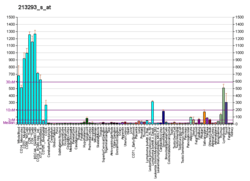TRIM22
Tripartite motif-containing 22, also known as TRIM22, is a protein which in humans is encoded by the TRIM22 gene.[3][4][5]
Function
The protein encoded by this gene is a member of the tripartite motif (TRIM) family.[6] The TRIM motif includes three zinc-binding domains, a RING, a B-box type 1 and a B-box type 2, and a coiled-coil region. This protein localizes to the cytoplasm and its expression is induced by interferon.[3] TRIM22 is also a target gene of the tumor suppressor protein p53.[7]
TRIM22 possesses E3 ubiquitin ligase activity and is able to ubiquitinate itself with the assistance of the E2 enzyme UbcH5B. Furthermore, TRIM22 is located in the nucleus and therefore may function as a nuclear E3 ubiquitin ligase.[8]
Clinical significance
The protein down-regulates transcription from the HIV-1 long terminal repeat promoter region, suggesting that function of this protein may be to mediate interferon's antiviral effects.[3][4] Other proteins that function to restrict HIV replication include TRIM5alpha and APOBEC3G.[9]
It has been demonstrated that treatment of cells with interferon type I inhibits HIV replication and TRIM22 is strongly up-regulated by interferon treatment. Furthermore, HIV particle release from cells depleted of TRIM22 with RNA interference is enhanced. TRIM22 appears to prevent the movement of the HIV Gag protein to the plasma membrane and hence TRIM22 can block HIV replication in cell cultures by preventing the assembly of the virus.[10][11]
References
- GRCh38: Ensembl release 89: ENSG00000132274 - Ensembl, May 2017
- "Human PubMed Reference:". National Center for Biotechnology Information, U.S. National Library of Medicine.
- "Entrez Gene: TRIM22 tripartite motif-containing 22".
- Tissot C, Mechti N (June 1995). "Molecular cloning of a new interferon-induced factor that represses human immunodeficiency virus type 1 long terminal repeat expression". J. Biol. Chem. 270 (25): 14891–8. doi:10.1074/jbc.270.25.14891. PMID 7797467.
- Gongora C, Tissot C, Cerdan C, Mechti N (November 2000). "The interferon-inducible Staf50 gene is downregulated during T cell costimulation by CD2 and CD28". J. Interferon Cytokine Res. 20 (11): 955–61. doi:10.1089/10799900050198390. PMID 11096452.
- Reymond A, Meroni G, Fantozzi A, Merla G, Cairo S, Luzi L, Riganelli D, Zanaria E, Messali S, Cainarca S, Guffanti A, Minucci S, Pelicci PG, Ballabio A (May 2001). "The tripartite motif family identifies cell compartments". EMBO J. 20 (9): 2140–51. doi:10.1093/emboj/20.9.2140. PMC 125245. PMID 11331580.
- Obad S, Olofsson T, Mechti N, Gullberg U, Drott K (October 2007). "Regulation of the interferon-inducible p53 target gene TRIM22 (Staf50) in human T lymphocyte activation". J. Interferon Cytokine Res. 27 (10): 857–64. doi:10.1089/jir.2006.0180. PMID 17970695.
- Duan Z, Gao B, Xu W, Xiong S (September 2008). "Identification of TRIM22 as a RING finger E3 ubiquitin ligase". Biochem. Biophys. Res. Commun. 374 (3): 502–6. doi:10.1016/j.bbrc.2008.07.070. PMID 18656448.
- Huthoff H, Towers GJ (December 2008). "Restriction of retroviral replication by APOBEC3G/F and TRIM5alpha". Trends Microbiol. 16 (12): 612–9. doi:10.1016/j.tim.2008.08.013. PMC 3556578. PMID 18976920.
- "Researchers discover gene that blocks HIV". Medicine & Health / HIV & AIDS. PhysOrg.com. 2008-02-29. Retrieved 2009-02-22.
- Barr SD, Smiley JR, Bushman FD (February 2008). Hope TJ (ed.). "The interferon response inhibits HIV particle production by induction of TRIM22". PLOS Pathog. 4 (2): e1000007. doi:10.1371/journal.ppat.1000007. PMC 2279259. PMID 18389079.
External links
- TRIM22 human gene location in the UCSC Genome Browser.
- TRIM22 human gene details in the UCSC Genome Browser.


